Teodorescu P.P. Mechanical Systems, Classical Models Volume I: Particle Mechanics
Подождите немного. Документ загружается.


MECHANICAL SYSTEMS, CLASSICAL MODELS
582
trajectory not being affected by a decisive influence; thus, if the velocity of the
interplanetary vehicle is less than the second cosmic velocity of a celestial body in the
vicinity of which it passes at the distance
0
r , then the vehicle is captured by the
respective celestial body.
2.2.3 Study of conditions to become a satellite
One can obtain a graphical image of conditions to become a satellite by introducing
the non-dimensional variables
0
10
r
H
RR
ξ =−=≥
,
2
2
00
I
0
vv
gR v
η
⎛⎞
=
=>
⎜⎟
⎝⎠
;
(9.2.41)
the conditions (9.2.35), to which we associate also the first condition (9.2.33'), take the
form
22
0
12 2
11
(1 ) (1 ) sin 1
ξξ
η
ξξ
ξξα
−
≤≤<
++
++ −
⎡⎤
⎣⎦
,
(9.2.42)
with
0
1
1
sin
ξ
α
≥−
.
(9.2.42')
In a system of co-ordinate axes
Oξη we draw the arcs of rectangular hyperbola
0
γ and
0
γ of equations (Fig.9.14)
2
1
η
ξ
=
+
,
1
1
ξ
η
ξ
−
=
+
;
(9.2.43)
the domain
D , the points (, )ξη of which verify the conditions (9.2.42) to become a
satellite, is contained between these curves and the axes
Oη ( 0ξ ≥ ) and Oξ ( 0η > ).
To specify this domain we draw also the curves
0
()γγα
=
of equation
22
0
2
(1 ) (1 ) sin 1
ξ
η
ξξα
=
+
+−
⎡
⎤
⎣
⎦
.
(9.2.43')
Because
[]
2
0
2
22
0
0
2(1 )sin2
d
d
(1 ) (1 ) sin 1
ξξ α
η
α
ξξα
+
=−
++ −
,
it results that
0
d/d 0ηα< for
0
(0, /2)απ
∈
,
0
d/d 0ηα
=
for
0
/2απ= and
0
d/d 0ηα> for
0
(/2,)αππ∈ . Hence, if
0
α increases from
0
0α
=
(without that
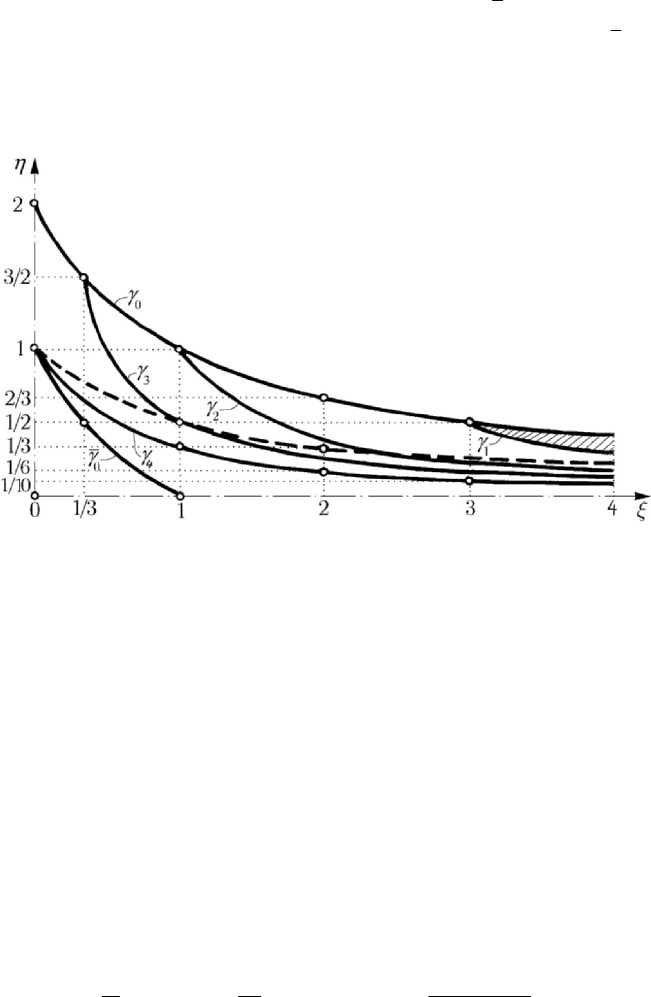
Newtonian theory of universal attraction
583
value), then the curve
0
()γα goes down till a position corresponding to
0
/2απ= ;
then
0
()γα goes up together with the increasing of
0
α . We notice that
00
() ( )γα γπ α=−. The curves
0
()γα are over the curve
0
γ
, so as it was to be
expected (only the curve
4
(/2)γγπ
=
has a common point with the curve
0
γ
). The
domain
0
()DDα
=
for which exists the possibility to become a satellite (a height H
being given, there corresponds a lot of possible initial velocities
0
v ) is contained
between the curves
0
γ and
0
()γα (without the frontier
0
γ ), which are piercing at the
Figure 9.14. Graphic representation of the conditions to become a satellite in the Oξη - plane.
points of co-ordinates
2
0
cotξα= ,
2
0
2sinηα= . In Fig.9.14 are drawn the curves
1
(/6)γγπ= ,
2
(/4)γγπ= ,
3
(/3)γγπ
=
and
4
(/2)γγπ
=
(the domain
(/6)D π for which one gets a satellite is hatched). The maximal such domain is
(/2)D π and is contained between the curves
0
γ and
4
γ , being bounded by the axis
0ξ =
. Indeed, only in this case we may have
0H
=
; if
0
/2απ
≠
, then a possibility
to become a satellite takes place only for
2
0
cotξα> .
(9.2.44)
The condition (9.2.42') is included in the condition (9.2.44) because
00
(1 sin )/ sinαα−
2
0
cot α< .
The trajectory of the satellite is a circle if the eccentricity vanishes (
0e =
); taking
into account (9.2.7), (9.2.7') and observing that
2
f
MgR= , we must have
simultaneously
2
0
10
p
r
⎛⎞
−=
⎜⎟
⎝⎠
,
2
2
0
2
0
cot 0
p
r
α
=
,
22 2
00 0
2
sinrv
p
gR
α
=
.
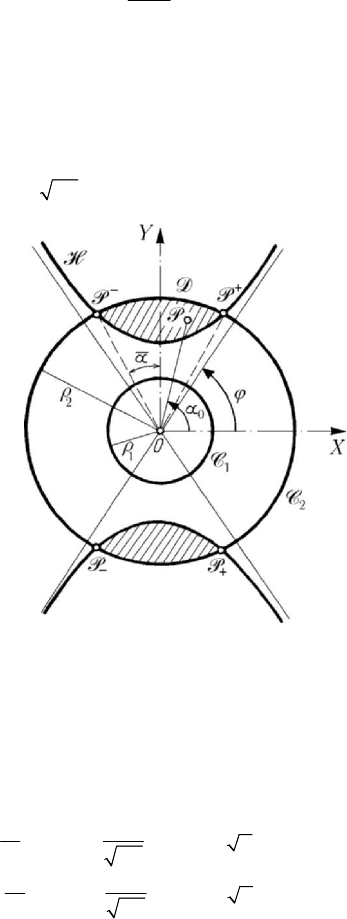
MECHANICAL SYSTEMS, CLASSICAL MODELS
584
It results that
0
/2απ= ,
2
00
//vgRRr= . With the notations introduced above, we
may write
1
1
η
ξ
=
+
;
(9.2.45)
this arc of rectangular hyperbola (contained in the maximal domain
(/2)D π ),
represented by a broken line in Fig.9.14, specifies the velocity
0
v by which a vehicle
must be launched in the space from a given height
H so that to become a satellite of
the Earth, having a circular trajectory.
An analogous study has been effected by L. Dragoş, using the non-dimensional
variables
0
/rR and
0
/vgR.
Figure 9.15. Graphic representation of the conditions to become a satellite
in the
OXY - plane.
A graphical interpretation of the conditions to become a satellite may be obtained in
the hodographic plane too; following a study made by C. Iacob (who used the
dimensional co-ordinates
00
cosv α and
00
sinv α ), we introduce the non-dimensional
co-ordinates
00
000
I
cos cos cos
vv
X
v
gR
ααηα== =,
00
000
I
sin sin sin
vv
Y
v
gR
ααηα== =
(9.2.46)
of the extremity of the position vector
0
I
/vv. The conditions (9.2.35) to become a
satellite take the form
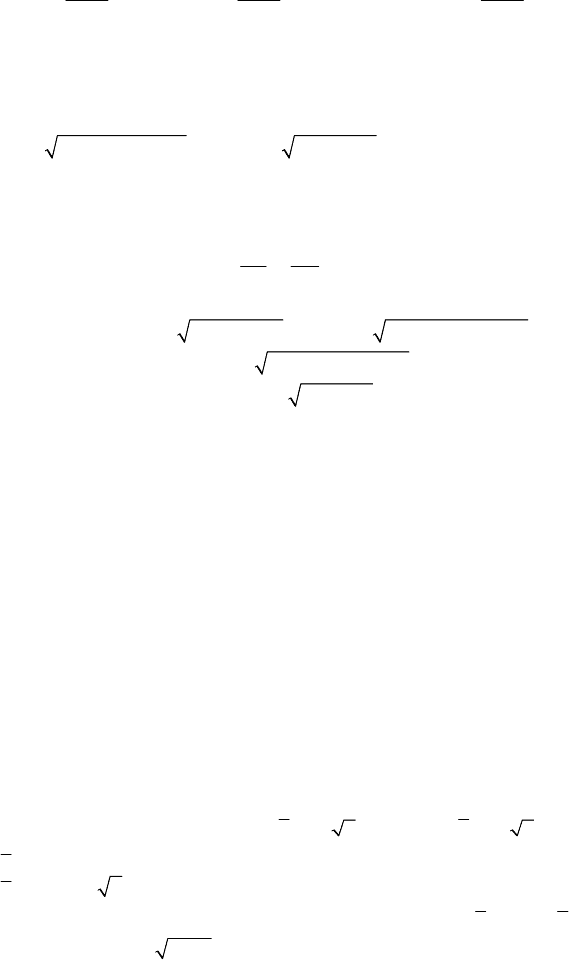
Newtonian theory of universal attraction
585
22
12
11
XY
ξ
ξξ
−
≤+<
+
+
,
22
2
(2 )
1
YX
ξ
ξξ
ξ
+−≥
+
,
(9.2.47)
to which we associate the condition (9.2.42'); we took into account the notation
(9.2.41). The first inequalities show that the point
(,)XYP must be in the interior of
the circular annulus, bounded by the circles
1
C and
2
C of radii
1
(1 )/(1 )ρξξ=− + and
2
2/(1 )ρξ=+, respectively, or on the internal frontier
of it (Fig.9.15). As well, this point must be interior to the hyperbola
H of equation
(regions of the plane which do not contain the origin
O
)
22
22
1
YX
βα
−
=
(9.2.48)
and of semiaxes
2/(1 )αξξ=+ and 2/(1 )(2 )βξξ=++; the foci (0, )γ and
(0, )γ− are specified by 2(1 )/(2 )γξξ=+ +. The asymptotes of the hyperbola
make an angle
ϕ given by cot (2 )ϕξξ=+ with the
OX
-axis.
If we draw a tangent from the launching point
0
P
to the Earth sphere, then we notice
that the angle
ϕ is just the angle made by this tangent with the straight line
0
PF
′
(Fig.9.13). The condition (9.2.42') leads to
0
cot (2 )αξ ξ
≤
+ , so that
0
cot cotαϕ≤
;
hence,
0
αϕ≥
(the point (,)XYP must be in the interior of the asymptotes’ angle,
which contains the hyperbola
H, condition which is fulfilled together with the second
condition (9.2.47)). If
0
αϕ
<
(the point (,)XYP being in the interior of the
asymptotes’ angle, which does not contain the hyperbola
H ), then the trajectory of the
vehicle launched from the Earth surface pierces the Earth sphere immaterial of the
launching velocity. These conditions are easily justified in Fig.9.15.
We have
12
ρβρ<<. Hence, one can launch satellites of the Earth from a given
height
H , that is for a given ξ , if the initial velocity
0
v and the direction of the
launching
0
α are so that the point (,)XYP be in the interior of the domain D
bounded by arcs of hyperbola
H and arcs of circle
2
C (the hatched regions in Fig.
9.15). The points
,,
+−
+
PPP and
−
P of intersection of the hyperbola H with the
circle
2
C have the co-ordinates
2/(1 )X ξξ
=
±+
,
2/(1 )Y ξ
=
±+
. The angle
α
formed by the OY -axis with the semi-lines O
+
P and O
−
P is given by
arctanαξ= ; it results that the launching angle
0
α depends on ξ , hence on the
launching height
H , and that we must have
[
]
0
/2 , /2απ απ α
∈
−+.
The point
(
)
0,1/ 1 ξ+ corresponds to a circular trajectory.
The discussion has been made for
0Y > ; for 0Y
<
one obtains analogous results
and a trajectory symmetric to the first one.
In conclusion, if the point
(,)XYP belongs to the interior of the circle
2
C , then
the trajectory is an ellipse (if
∈
PD, then the trajectory does not intersect the Earth’s

MECHANICAL SYSTEMS, CLASSICAL MODELS
586
sphere), if the point
P is on the circle
2
C , then the trajectory is a parabola, while if the
point
P belongs to the exterior of the circle
2
C , then the trajectory is an arc of
hyperbola. A supplementary study is necessary to see if these arcs of parabola or of
hyperbola intersect the Earth’s sphere.
2.2.4 Study of the satellite orbit
As we have seen in Subsec. 2.2.2 too, in a more exact theory we must take into
account the resistance of the atmosphere. As well, we must notice that the Earth is
neither spherical, nor homogeneous, so that the potential created by it is only with a
certain approximation equal to the potential of a particle situated at the mass centre of
the Earth and at which would be concentrated its whole mass; we may use with a better
approximation the formula (9.1.18) for the potential
()Ur of the terrestrial spheroid.
The equation of motion reads (
s
m is the satellite mass)
grad
ss
i
mfm Umψ=−av,
(9.2.49)
where we have introduced the resistance
()
s
mtψ=−Rv, () (())tvtψψ= . In
spherical co-ordinates we can write (see Chap. 5, Subsecs 1.1.3 and 1.2.4)
222
sin
U
rr r f r
r
θθϕ ψ
∂
−− = −
∂
,
()
222 2
d1
sin 2
d2
U
rr f r
t
θθϕψθ
θ
∂
−=−
∂
,
()
22 22
d
sin sin
d
U
rfr
t
θϕ ψ θϕ
ϕ
∂
=−
∂
.
(9.2.49')
The terrestrial spheroid has properties of axial symmetry, so that
/0U ϕ
∂
∂=; the
third equation (9.2.49') leads thus to the first integral
0
()d
22 22
000
sin sin e
t
t
rr
ψτ τ
θϕ θ ϕ
−
∫
=
,
(9.2.49'')
with
00
()rrt= ,
00
()tθθ= ,
00
()tϕϕ
=
. In particular, if the satellite is launched in
a meridian plane (
0000
() sin 0vt r
ϕ
θϕ
=
= ), then sin 0vr
ϕ
θϕ
=
= , hence
constϕ = ; thus, the satellite continues its motion in the meridian plane. In this case,
the equations of motion are
2
U
rr f r
r
θψ
∂
−= −
∂
,
()
22
d
d
U
rf r
t
θψθ
θ
∂
=−
∂
.
(9.2.50)
If, in a first approximation, we take
/0U θ
∂
∂= , then we get a second first integral
(
00
()tθθ=
)
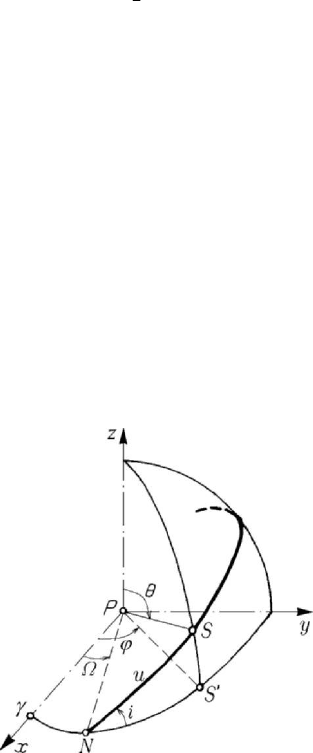
Newtonian theory of universal attraction
587
0
()d
22
00
e
t
t
rr
ψτ τ
θθ
−
∫
=
,
(9.2.50')
which shows that the areal velocity
2
/2rΩθ=
has an exponential variation.
The spherical co-ordinates
()tθθ
=
and ()tϕϕ
=
of the satellite S being
determined, the problem to specify the orbit co-ordinates on the celestial sphere of
radius equal to unity is put. We choose a geocentric frame of reference (which we
assume to be inertial) with the origin at the Earth centre
P ; the principal plane is the
equatorial one and the
Px -axis is contained in this plane, being directed towards the
first point of Aries
γ (the vernal equinoctial point) (at the intersection of the equatorial
plane with the ecliptic plane, which contains the trajectory described by the Earth); the
Oz -axis is normal to this plane (it is the rotation axis of the Earth). The line of nodes
PN is specified by the angle Ω in the plane Pxy ; the plane of satellite’s orbit, which
passes through
PN , is inclined on the principal plane by the angle i . The position S
of the satellite is – in this case – given by
arcuNS
=
(Fig.9.16). Applying the
formulae of spherical trigonometry to the spherical triangle
NS S
′
, rectangular in S
′
,
we get the relations
Figure 9.16. Trajectory of a satellite.
cot tan sin( )i θϕΩ=−, cos sin cos( )u θϕΩ
=
− ,
(9.2.51)
which give the angles
i and u . We mention also the relation
sin sin cosiu θ
=
. (9.2.51')
2.3 Applications to the theory of motion at the atomic level
The motion of a particle electrically charged, e.g. of an electron in the vicinity of an
atomic nucleus, must be studied in the frame of the quantic model of mechanics;
however, one can obtain many interesting and useful results in the frame of the
Newtonian model too. After presenting the classical model of the atom, based on

MECHANICAL SYSTEMS, CLASSICAL MODELS
588
Hertz’s oscillator, we pass to the study of Bohr’s atom; by this occasion, we put in
evidence Ritz’s law too, which characterizes the lines spectrum of hydrogen.
2.3.1 Hertz’s oscillator. Classical model of the atom
If an electric charge
00
ee ε= , where
0
e is the rationalized electric charge,
0
ε
is the permittivity of the vacuum, while
is a coefficient of rationalization ( 1= in
case of a non-rationalized system and
4π
=
in case of a rationalized one, e.g., the
SI-system), passes from a condenser coat to another one (a rhythmical variation of the
armatures’ polarity by an alternative variation of the tension applied upon them), then
one obtains an experimental device which emits electromagnetic waves, equivalent to a
linear oscillator dipole of moment
000
/pp exε
=
= , where x is the elongation,
called Hertz’s oscillator. This device emits (i.e. it loses) energy in the form of
spontaneously radiated energy, expressed by the power
222
00
33
22
33
Pp ex
cc
==
,
(9.2.52)
where
c is the velocity of light propagation in vacuum; the upper line indicates the
mean value. Starting from the equation of motion (8.2.23), we may write
242
xxω= ;
taking into account the form (8.2.24) of the solution and observing that
2
0
11
cos ( )d
2
T
tt
T
ωϕ
−
=
∫
,
we obtain
2442
8xaπν= , where a is the amplitude, while ν is the frequency given
by (8.2.6'). It results
224
4
0
3
16
3
ea
P
c
ν
π
=
.
(9.2.52')
Thus, by radiation, a quantity of mechanical energy
d/dEt P
=
− is lost from the
mechanical energy
E given by (8.2.23''). We can write d/dEt Eγ
=
− , wherefrom
0
e
t
EE
γ
−
= ,
22
2
0
3
8
3
e
mc
ν
π
γ =
,
(9.2.53)
γ being the radiation constant; as it was shown by Max Planck, one obtains thus a
damping effect.
The classical model of the atom is an oscillator of Hertz, that is an electron which
oscillates around a position of equilibrium, where there is an atomic nucleus. But this
mechanical system loses permanently energy, as we have seen above; because of this
damped motion, after a sufficiently long (but finite) time, the electron falls towards the
nucleus. Such a model of atom is labile and does not correspond to the reality; but it can
be considered as satisfactory for a great lot of physical phenomena.

Newtonian theory of universal attraction
589
We notice that
2
EKa= , constK
=
; taking into account (9.2.53), it results also
for the amplitude a variation of the form
/2
0
e
t
aa
γ−
= ,
(9.2.54)
which characterizes a damped motion. Hence, the equation of motion of the electron
quasi-elastically linked in the atom should be of a corresponding form.
If
F is the force which arises under the influence of the atomic radiation, acting
upon the oscillator itself and damping its motion, then we are led to the equation of
motion
2
mx m x Fω+= ; multiplying by x , we obtain d/dEtFx=
(
)
232
0
2/3ecx=− (where we considered the non-averaged power), with
(
)
222
/2Emvmxω=+
. Taking into account (9.2.52) and observing that
2
d( )/dxxxt= xx− , we may write
22
00
0
33
22
33
T
ee
Fx xx xx
cc
=−
;
assuming that the period
T is sufficiently small, the second term may be neglected
with respect to the first one and we can take
2
0
3
2
3
e
Fx
c
=
.
(9.2.55)
We obtain thus the equation of motion of the electron quasi-elastically linked to the
atom in the form
2
0
2
3
2
0
3
e
mx m x x
c
ω
+
−= .
(9.2.56)
Introducing the radiation constant
22
0
3
2
3
e
mc
ω
γ =
,
(9.2.53')
the equation (9.2.56) becomes
24
0xxx
ωω
γγ
−
−= .
(9.2.56')
Choosing a solution of the form
()
t
xt e
χ
= , we find the condition
3224
0γχ ω χ ω−−=
. Let us introduce the function
3224
()ϕχ γχ ωχ ω=− −
; we
notice that
()ϕ −∞ = −∞ ,
4
(0)ϕω
=
− , ()ϕ
∞
=∞. As well, d/dϕχ
2
3γχ=
2
2ωχ− ,
22 2
d/d 6 2ϕχ γχ ω=−. We obtain the graphic representation in Fig.9.17.
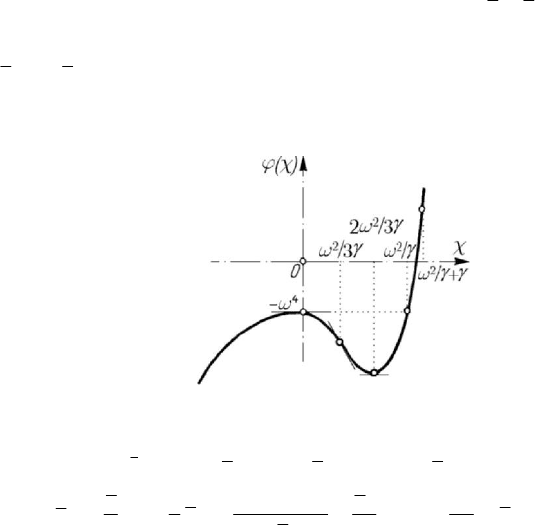
MECHANICAL SYSTEMS, CLASSICAL MODELS
590
We have thus only one real root of the form
2
/ωγγ
+
, (0, )γγ
∈
, because
(
)
24
/ϕω γ ω=− ,
(
)
(
)
2222
/2ϕω γ γ γ ω γ+= + ; the other two roots are
/2 iγω−± (the sum of the roots is
2
/ωγ). Hence, the general integral of the
equation (9.2.56') is of the form (we use the other two Viète’s relations between the
roots and the coefficients)
Figure 9.17. Graphic of the function ()ϕχ.
/2
() e ( cos sin ) e
tt
xt A t B t C
γω
ωω
′
−
=++, (0, )γγ
∈
,
22
222
2
3
44
1/
γγω
ωωγ
γ
γγ ω
=+= −
+
,
2
ω
ωγ
γ
′
=
+ .
(9.2.57)
The phenomenon corresponds to damped oscillations, so that one can take
0C = .
2.3.2 Bohr’s atom. Ritz’s law
The classical model of the atom gives some useful information with a sufficient good
approximation for some physical phenomena, but it is invalidated by other physical
phenomena, e.g. the spectral emissions (in the form of lines spectra). In 1913, Niels
Bohr, starting from Rutherford’s conception, which considers a model similar to that of
the solar system, develops a new model of the atom. Assuming the existence of a
central nucleus, formed by positive charges, and of electrons with negative charges,
attracted correspondingly to Coulomb’s law (1.1.84''), one obtains a mechanical system
in motion after Kepler’s laws. As a consequence of the lose of energy, on a way
analogous to that presented in the previous subsection, we are led to the motion of the
axis of the elliptic trajectory, hence to the possibility of falling of the electron towards
the nucleus (the so-called atomic catastrophe). To avoid such a phenomenon in the
mathematical model, N. Bohr completed it with following principles: i) The electrons
describe elliptic trajectories around the nucleus, after Kepler’s laws, without lose of
energy by radiation; from the set of all possible trajectories, these ones are stationary,
characterized by quantic conditions. ii) In conformity to the quantification conditions,
the integral of the generalized momentum corresponding to each generalized co-
ordinate (to each degree of freedom) along the complete trajectory must be an
integer multiple of Planck’s universal constant
27
6.626196 10 erg sh
−
=
⋅⋅ for the

Newtonian theory of universal attraction
591
stationarity trajectories. iii) The emission of radiations takes place only if the electron
“jumps” from a stationary trajectory on another stationary trajectory, due to an external
excitation.
In case of a single electron which moves around a nucleus, Bohr’s model
corresponds to the atom of hydrogen. We consider thus the motion of a particle of mass
m , which has a negative electric charge and moves around a positive centre of
attraction being acted upon by a Coulombian force which derives from the potential
/kr, 0k > . In our case,
22
00
/ke e ε== , where
19
1.6021917 10 Ce
−
=⋅ (in
coulombs) is the electric charge in the SI-system; the coefficient
ε in (1.1.84'') is, in
this case, equal to unity.
Taking into account (9.2.6) and (9.2.12'), we may write the equation of the elliptic
trajectory in the form
(
)
2
1
1cos
ae
r
e ψ
−
=
+
(9.2.58)
1
ψθθ=−
being the real anomaly. Because the kinetic energy is given by
(
)
222
/2Tmr rθ=+
, we define the generalized momenta corresponding to polar co-
ordinates by
r
T
pmr
r
∂
==
∂
,
22
T
pmrmrmC
θ
θψ
θ
∂
== = =
∂
,
(9.2.59)
where
C is the constant of areas. The stationarity trajectories are thus specified by the
quantification conditions
d
r
pr nh
′
=
∫
v
,
2
0
dpnh
π
θ
ψ =
∫
, ,nn
′
∈
` ,
(9.2.59')
where
h is Planck’s constant; the integrals are calculated along the complete trajectory
(for the first integral,
r varies from
min
r to
max
r and again to
min
r ). Observing that
()
2
22
2
22
2
dsin
dd1 d
d
(1 cos )
re
mr r m ma e
e
ψ
ψψ ψψ
ψ
ψ
⎛⎞
==−
⎜⎟
⎝⎠
+
22 22
2
22
sin sin
dd
(1 cos ) (1 cos )
ee
mr mC
ee
ψψ
ψψ ψ
ψψ
==
++
,
we may write
2
2
22
2
2
00
0
sin sin cos d
dd
1cos 1cos
(1 cos )
r
pr mCe mCe
ee
e
π
ππ
ψψψψ
ψ
ψψ
ψ
⎛⎞
==−
⎜⎟
++
+
⎝⎠
∫∫ ∫
v
2
2
2
0
0
tan
12
2
1d arctan 2
1cos
1
1
1
mC
mC mC
e
e
e
e
π
π
ψ
ψπ
ψ
⎛⎞
=−= −
⎜⎟
+
−
⎝⎠
−
+
∫
